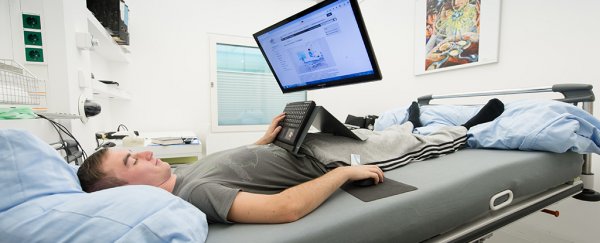Lying in bed in the name of science may sound like a dream job, but when you're volunteering to do that for NASA, there's inevitably going to be a catch.
The space agency's latest bed rest study is meant to investigate the effects of fluid pressure on the eyes and optic nerves of astronauts. To do that, participants must spend 30 days not getting up from a bed - but it's not as fun as it sounds.
Twelve volunteers will be spending a solid month in large beds that are tilted downwards at a six-degree angle, and they must remain in that position the whole time.
No getting up to pee or shower. No sitting upright to have their meals.
And in addition to the posture, the participants will also be breathing air that's much higher in carbon dioxide (CO2) - 0.5 percent as opposed to the mere 0.04 percent we get with our normal everyday Earth air.
All this is meant to produce an adaptive response in the body akin to what happens to astronauts living in microgravity. The reason for the altered CO2 levels is part of the strategy, since on the International Space Station CO2 levels also tend to be higher than down on the planet.
"These conditions will mimic the environment thought to cause vision problems experienced by some astronauts," NASA explains in a statement.
The new study is part of the agency's Flight Analogs Program, which is exactly what it sounds like - studying the effects of spaceflight on the human body in analog environments here on Earth.
The bedrest marathon will take place at German Space Agency's state of the art facility :envihab, where participants will be spending time in their specially equipped bedrooms with no visitors allowed on site (although they can keep their phones).
The volunteers have been arriving at the facility this week, and will go through two weeks of baseline data collection before being confined to bed rest in a staggered schedule of two subjects per day.
All participants will be closely monitored to let researchers better understand the changes a person's body undergoes in space, especially when it comes to pressure on the eyes and the optic nerve.
"There is continuous data collection including several MRIs to observe potential changes in either brain or eye structures," states NASA.
"Blood pressure, heart rate, nutrient absorption, energy expenditure, bone mass and even the participants' mood will also be monitored."
If you ever dream of just ditching life's obligations and staying in bed with some Netflix on your laptop and a pile of junk food, this wouldn't be the way to do it, since even the participant's diets will be strictly controlled, giving them "little choice as to what or when they eat."
But hey, nobody said astronauts have it easy.
This is not the first time NASA has done a bed rest study, and they're not even the only organisation to do this kind of science.
Last year the Institute for Space Medicine and Physiology in France was recruiting 24 volunteers for a similar 60-day stint, and there is even a report from the field by one man who participated in a 70-day bedrest study for NASA.
As test subject Andrew Iwanicki described in his report for Vice, at first it was one of the most relaxing times in his adult life, but as the weeks drew on, boredom and monotony settled in, followed by an intense frustration over the extremely strict diet.
Thankfully these volunteers will only be in bed for a third of that time, and we're looking forward to finding out what the scientists may learn about vision problems in astronauts.
"Many participants want to do their part to support space travel," explains NASA.
"If humans ever walk on Mars or live in space for long periods, it is in part, thanks to the bed rest volunteers."
